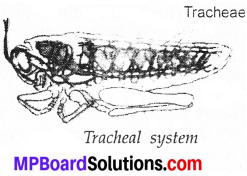MP Board Class 7th Science Solutions Chapter 10 Respiration in Organisms
Respiration in Organisms Intex Questions
Question 1.
Bhoojho wants to know if cockroaches, snails, fish, earthworms, ants and mosquitoes also have lungs?
Answer:
Yes.
Question 2.
Boojho has seen in television programmes that whales and dolphins often come up to the water surface? They even release a fountain of water sometimes while moving upwards? Why do they do so?
Answer:
Whales and dolphins take in air during inhalation. They exhale out the air on the surface. The water vapour condenses and we see the condensed water vapour as the fountain.
![]()
Question 3.
Paheli wants to know whether roots, which are under ground also take in oxygen? If so, how?
Answer:
Yes. Roots take up air from the air spaces preseht between the soil particles.
Activities
Activity – 1
If you try you can count your rate of breathing. Breathe in and out normally. Find out how many times you breathe in and breathe out in a minute? Did you inhale the same number of times as you exhaled? Now count your breathing rate (number of breaths/minute) after brisk walk and after running. Record your breathing rate as soon as you finish and also after complete rest. Tabulate your findings and compare your breathing rates under different conditions with those of your classmates.
Table:
Changes in breathing rate under different conditions:
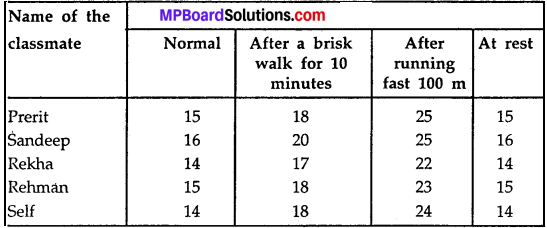
Activity – 2
Figure shows the various activities carried out by a person during a normal day. Can you say in which activity, the rate of breathing will be the slowest and in which it will be the fastest? Assign numbers to the pictures in the order of increasing rate of breathing according to your experience.
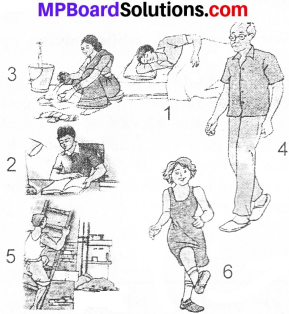
Activity – 3
Take a deep breath. Measure the size of the chest with a measuring tape and record your observations in Table. Measure the size of the chest again when expanded and indicate which classmate shows the maximum expansion of the chest.
Answer:
Effect of breathing on the chest size of some classmates:
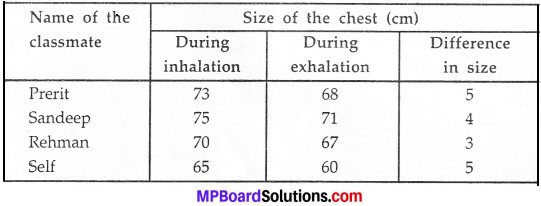
Respiration in Organisms Text Book Exercise
Question 1.
Why does an athlete breathe faster and deeper than usual after finishing the race?
Answer:
During the race, the athlete has to run very fast. The demand for energy at that time increases, which increase the demand for more supply of oxygen. Thus, athlete has to breathe faster and deep to inhale more oxygen.
Question 2.
List the similarities and differences between aerobic and anaerobic respiration?
Answer:
Similarities:
Both aerobic and anaerobic respiration produce energy and give out carbon dioxide.
Differences:
Aerobic respiration require oxygen while anaerobic respiration does not require oxygen. In aerobic respiration large amount of energy is released while in anaerobic respiration small amount of energy is released.
Question 3.
Why do we often sneeze when we inhale a lot of dust laden air?
Answer:
We sneeze to get rid of the unwanted particles like dust from air body. It allows only clean and dust free air to enter our body.
![]()
Question 4.
Take three test – tubes. Fill \(\frac{1}{2}\)th of each with water. Label them A, B and C. Keep a snail in test – tube A, a water plant in test – tube B and in C, keep snail and plant both. Which test – tube would have the highest concentration of CO2?
Answer:
Test – tube A.
Question 5.
Tick the correct answer:
Question (a)
In cockroaches, air enters the body through?
(a) lungs
(b) gills
(c) spiracles
(d) skin.
Answer:
(c) spiracles
Question (b)
During heavy exercise, we get cramps in the legs due to the accumulation of?
(a) carbon dioxide
(b) lactic acid
(c) alcohol
(d) water.
Answer:
(b) lactic acid
Question (c)
Normal range of breathing rate per minute in an average adult person at rest is?
(a) 9 – 12
(b) 15 – 18
(c) 21 – 24
(d) 30 – 33
Answer:
(b) 15 – 18
Question (d)
During exhalation, the ribs?
(a) move outwards
(b) move downwards
(c) move upwards
(d) do not move
Answer:
(b) move downwards
Question 6.
Match the items in Column I with those in Column II:
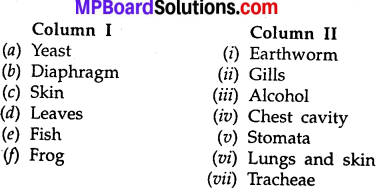
Answer:
(a) – (iii)
(b) – (iv)
(c) – (i)
(d) – (v)
(e) – (ii)
(f) – (vi)
Question 7.
Mark if the statement is true and if it is false:
- During heavy exercise the breathing rate of a person slows down.
- Plants carry out photosynthesis only during the day and respiration only at night.
- Frogs breathe through their skins as well as their lungs.
- The fishes have lungs for respiration.
- The size of the chest cavity increases during inhalation.
Answer:
- False
- False
- True
- False
- True
![]()
Question 8.
Given below is a square of letters in which are hidden different words related to respiration in organisms. These words may be present in any direction – upwards, downwards, or along the diagonals. Find the words for your respiratory system. Clues about those words are given below the square?
- The air tubes of insects
- Skeletal structures surrounding chest cavity
- Muscular floor of chest cavity
- Tiny pores on the surface of leaf
- Small openings on the sides of the body of an insect
- The respiratory organs of human beings
- The openings through which we inhale
- An anaerobic organism
- An organism with tracheal system
Answer:
- Trachea
- Rib
- Diaphragm
- Stomats
- Spiracles
- Lung
- Strils
- Yeast
- Ant.

Question 10.
The mountaineers carry oxygen with them because:
(a) At an altitude of more than 5 km there is no air.
(b) The amount of air available to a person is less than that available on the ground.
(c) The temperature of air is higher than that on the ground.
(d) The pressure of air is higher than that on the ground.
Answer:
(b) The amount of air available to a person is less than that available on the ground.
Extended Learning – Activities and Projects
Question 1.
Observe fish in an aquarium. You will find flap like structures on both sides of their heads. These are flaps which cover the gills. These flaps open and close alternately. On the basis of these observations, explain the process of respiration in the fish?
Answer:
Do with the help of your subject teacher.
Question 2.
Visit a local doctor. Learn about the harmful effects of smoking. You can also collect material on this topic from other sources. You can seek help of your teacher or parents. Find out the percentage of people of your area who smoke. If you have a smoker in your family, confront him with the material that you have collected?
Answer:
Do yourself.
Question 3.
Visit a doctor. Find out about artificial respiration? Ask the doctor:
(a) When does a person need artificial respiration?
(b) Does the person need to be kept on artificial respiration temporarily or permanently?
(c) From where can the person get supply of oxygen for artificial respiration?
Answer:
Do yourself.
![]()
Question 4.
Measure the breathing rate of the members of your family and some of your friends? Investigate:
(a) If the breathing rate of children is different from that of adults?
(b) If the breathing rate of males is different from that of females?
If there is a difference in any of these cases, try to find the reason?
Answer:
Do with the help of your parents.
Respiration in Organisms Additional Important Questions
Objective Type Questions
Question 1.
Choose the correct alternative:
Question (a)
The life processes that provide energy are?
(a) respiration
(b) nutrition
(c) both respiration and nutrition
(d) none of these.
Answer:
(c) both respiration and nutrition
Question (b)
In …………………… respiration, there is an exchange of gases between the cells and the blood?
(a) aerobic
(b) anaerobic
(c) external
(d) internal.
Answer:
(d) internal.
Question (c)
In the cell, the food (glucose) is broken down into carbon dioxide and water using?
(a) hydrogen
(b) nitrogen
(c) oxygen
(d) none of these.
Answer:
(c) oxygen
![]()
Question (d)
Which of the following is not a feature of respiration?
(a) involvement of enzymes
(b) occur outside the cells
(c) release of energy
(d) is a chemical process.
Answer:
(d) is a chemical process.
Question (e)
During heavy exercise, the breathing rate in an adult can increase upto?
(a) 25 times per minute
(b) 30 times per minute
(c) 35 times per minute
(d) none of these.
Answer:
(a) 25 times per minute
Question (f)
The percentage of oxygen and carbon dioxide in inhaled air is –
(a) 21%, 0.04%
(b) 20%, 0.10%
(c) 21%, 1.0%
(d) 20%, 1.0%.
Answer:
(a) 21%, 0.04%
Question (g)
The percentage of oxygen and carbondioxide in exhalted air is –
(a) 16.4%, 4.4%
(b) 21%, 1.0%
(c) 16.4%, 3.4%
(d) 16.4%, 0.04%.
Answer:
(a) 16.4%, 4.4%
Question 1.
Fill in the blanks:
- All living organisms require ………………………… to perform various life process.
- The liver and ……………………… are found near the stomach.
- The exhaled air has a higher percentage of carbon dioxide as compared to the ……………………………… air.
- Breathing is a process at organ levels, whereas respiration is a ……………………….. process.
- When breakdown of glucose occurs with the use of oxygen, it is called …………………….. respiration.
- The taking in of air rich in oxygen into the body is called …………………………
- The number of times a person breathes in a minute is termed as the ………………………….
- Lungs are present in the ……………………….. cavity.
- During inhalation, ribs move up and outwards and diaphragm moves ………………………..
- Insects have a network of air tubes called ……………………….. for gas exchange.
- Like all other living cells of the plants, the root cells also need oxygen to ………………………. energy.
Answer:
- energy
- pancreas
- inhaled
- cellular
- aerobic
- inhalation
- breathing rate
- chest
- down
- tracheae
- generate.
![]()
Question 3.
Which of the following statements are true (T) or false (F):
- Respiration is a type of combustion at ordinary temperature.
- Breathing is a process that takes place at the cellular level.
- Oxygen is released during the process of respiration.
- During respiration the plants – take CO2 and release Or
- Respiration involves on exchange of gases.
- Cellular respiration takes place in the cells of all organisms.
- Anaerobic respiration do not takes places in the muscle cells to fulfill the demand of energy.
- The giving out of air rich in carbon dioxide is known as exhalation.
- A breathe means one inhalation plus one exhalation.
- On an average, an adult human being at rest breathes in and out 15 to 18 times in a minute.
- A cockroach has small openings on the sides of its body.
- Gills are not supplied with blood vessels for exchange of gases.
- The end product of anaerobic respiration are carbon dioxide and water.
- In earthworm, the exchange of gases occurs through the moist skin.
Answer:
- True
- False
- False
- True
- True
- True
- False
- True
- True
- True
- True
- False
- True
- True
Respiration in Organisms Very Short Answer Type Questions
Question 1.
Where does cellular respiration takes place?
Answer:
Cells of organisms.
Question 2.
Write the equation for breakdown of food in anaerobic respiration?
Answer:

Question 3.
Write the equation for breakdown of food in aerobic respiration?
Answer:

Question 4.
What are anaerobes?
Answer:
There are some organisms such as yeast that can service in the absence of air. They are called anaerobes.
Question 5.
What is yeast?
Answer:
Yeast is single – celled organisms.
Question 6.
Write the uses of yeast?
Answer:
Yeast respire anaerobically and during this process yield alcohol. So, they are used to make beer and wine.
Question 7.
Which chemical reaction takes place in internal respiration?
Answer:
Glucose + Oxygen → Carbon dioxide + Water + Energy.
Question 8.
Give an example of an oxygen respiration?
Answer:
In human beings.
Question 9.
Name the parts of digestive system of humans?
Answer:
The parts of digestive systems are mouth, oesophagus, stomach, intestine and anus.
![]()
Question 10.
Name two processes of respiration?
Answer:
Inhalation and exhalation are the two processes of respiration.
Question 11.
Name the parts of respiratory system of human?
Answer:
- Nostrils
- Trachea
- Lungs with alveali, and
- Diaphragm.
Question 12.
What waste materials are produced during respiration?
Answer:
Carbon dioxide is produced as the waste material during respiration.
Question 13.
Define respiration?
Answer:
The process of breaking down of food by using oxygen, to form carbon dioxide and release energy required for various life activities, is called respiration.
Question 14.
Name the fuels used for the production of energy during respiration?
Answer:
Glucose is oxidized to give out energy.
Question 15.
Which organs of plants participate in respiration?
Answer:
There is no special organ in plants for breathing.
Question 16.
Write the names of organs in human respiratory system in sequence?
Answer:
Nostrils → Nasal cavity → Pharynx → Tracheae → Lungs.
Question 17.
What is importance of hairs present in the noise?
Answer:
These small hairs present in nose act as filters. These prevent dust particles and harmful germs to enter into respiratory track.
Question 18.
Name the organs of the body from which blood freshly enriched with oxygen goes into the heart?
Answer:
The lungs helps the blood to get freshly enrichment of oxygen.
Question 19.
What happens during breathing?
Answer:
During breathing, oxygen enriched air is inhaled which reaches lungs. Here, oxygen centers blood and unwanted water vapour and carbon dioxide are released out during breathing.
![]()
Question 20.
What is breathing?
Answer:
The process of taking oxygen and leaving of carbon dioxide during respiration is called breathing.
Question 21.
Write the name of gases which are involved in breathing?
Answer:
Carbon dioxide and oxygen.
Question 22.
How will you prove that we exhale CO2 gas during respiration?
Answer:
Pass the exhaled air given out by us into lime water. It will turn milky in colour. We know that CO2 gas turn lime water milky This confirms that we exhale CO2 gas in respiration.
Question 23.
What do we exhale?
Answer:
We exhale air rich in carbon dioxide.
Question 24.
Do we exhale only carbon dioxide or a mixture of gases along with it?
Answer:
We exhale a mixture of gases along with carbon dioxide.
Question 25.
How do ribs and diaphragm move during inhalation?
Answer:
During inhalation, ribs move up and outwards and diaphragm moves down.
![]()
Question 26.
Which is the respiratory organ for earthworm?
Answer:
Skin.
Question 27.
Can we survive in water?
Answer:
No.
Question 28.
How do fish breathe under water?
Answer:
Gills in fish help them to use oxygen dissolved in water. Gills are projections of the skin. Gills are well supplied with blood vessels for exchange of gases.
Question 29.
What is the function of gills?
Answer:
The fishes and other aquatic animals respire through gills or similar structure.
Question 30.
Can you guess what would happen if a potted plant is over watered?
Answer:
The roots will not get air to respire, so the roots will die and hence the whole plant will also die.
Respiration in Organisms Short Answer Type Questions
Question 1.
What is respiration?
Answer:
All the living organisms perform a number of vital activities. The energy is obtained by the oxidation of food or respiration. When the living organisms are completely at the stage of rest, even then they require some minimum amount of energy for the maintainance of cells and tissues. Thus, respiration is one of the most important process for living organisms.
Question 2.
Define respiration with the help of chemical equation?
Answer:
The process in which the oxidation of absorbed food is takes place by the CO2 which is inhaled by breathing and energy is released out is called respiration. Chemical equation of nutrition is as follows:
C6H12O2 + 6O2 → 6CO2 + 6H2O + 673 kcal (Energy)
Question 3.
Why does our body need a transporting system?
Answer:
Our body needs a transporting system to:
- Transport oxygen to body cells from lungs.
- Transport food to body cells from liver.
- Transport waste material from body cells to excretory organs.
- Maintains body temperature constant.
![]()
Question 4.
Write difference between oxy – respiration and anoxy – respiration?
Answer:
The differences between the oxy – respiration and anoxy – respiration:
oxy – respiration:
- It takes place in presence of O2
- The end products are CO2 and H2O.
- The energy released is more.
Anoxy – respiration:
- It takes place without oxygen.
- The end products are ethyl alcohol and CO2.
- The energy released
Question 5.
Describe the various types of respiratory organs found in animals?
Answer:
In animals, there are definite respiratory organs for exchange of gases.
- In earthworm and leech exchange of gases takes place through moist, thin and vascular skin.
- In insects the trachea are the repiratory organs.
- In fishes the gills are the respiratory organs.
- Higher animals like mammal and birds including man have lungs for respiration.
Question 6.
Describe the importance of respiration in plants?
Answer:
- It takes place in the presence of oxygen.
- It is completed in cytoplasm and mitochondria of cell.
- It involves the complete oxidation of glucose into CO2, and
- H2O + C2H2O2 + 6O2 → 6CO2 + energy + 6H2O.
- It occurs in all the living cell of the organisms.
- It is day night process.
- Energy is released in this process.
Question 7.
Name the organs associated with the following functions:
- digestion
- absorption of minerals
- respiration, and
- excretion of carbon – dioxide in man.
Answer:
1. Digestion. Mouth, stomach, oesophagus, pharynx, small intestine, large intestine.
2. Absorption of minerals.
In Animals : Small intestine
In plants : Root hairs.
3. Respiration.
In Animals : Nose, trachaea, larynx, lung.
In plants. Stomata and lenticells.
4. Excretion of carbon – dioxide.
In Animals : Kidneys, ureters, urinary bladder, urethra.
![]()
Question 8.
State the difference between respiration and breathing?
Answer:
Differences between Respiration and Breathing:
Respiration:
- It takes place inside the cells.
- The exchange of gases takes place between blood and the tissues of the body.
- In this process nutrients are oxidised to liberate energy.
Breathing:
- It takes place at the surface of the respiratory organs.
- The exchange of gases takes place between the blood and the external environment.
- The nutrients are not oxidised to liberate energy.
Question 9.
Name the major components of urine?
Answer:
The kidney, ureter, bladder, and urethra are the organs used in the removal of urine from the body. Renal artery carry urea and uric acid along with the large amount of water with the blood into the kindneys, when this blood enters into glomerulus, the solid wastes filter here while the water is diffused out from the network of blood capillaries into the uriniferous tubules. The ques mixture is called as urine.
Question 10.
If a person drinks very little water per day? The volume of urine decreases? In what ways does it affect the body?
Answer:
If a person drinks very little water per day. The volume of urine decreases. Large amount of water will dissolve large quantity of urea in it and large amount of urine will pass out from the body. If someone drinks lesser amounts of water, the concentration of urea in the cells and its larger quantity is very harmful for the body.
Question 11.
What is saliva? What are the functions of saliva?
Answer:
Saliva is a digestive secretion produced by three layered salivary glands, the paroted submaxillary and sunblingual present in our mouth cavity. This soften and lubricants food for easier swallowing and converts starch into reducing sugars. The salivary amylase. enzyme of saliva acts of starch in a neutral medium.
Question 12.
How does the food digested in the stomach?
Answer:
After some time from mouth the food reach inside the stomach. The gastric glands of stomach secrete the gastric juices. The gastric juice containes three enzymes. These are pepsin, renin and HCI. The HCI makes the medium acidic, and inhibites the bacterial growth and prevents the food. The renin curdiles the milk protein to be hydrololysed by pepsin. The pepsin reacts with proties and changes into peptides.
Respiration in Organisms Long Answer Type Questions
Question 1.
Define the respiratory organs in animals?
Answer:
The process of respiratory system in animals possess following organs:
- Nasal cavity
- Larynx
- Trachea
- Bronchi
- Lungs.
In animals some organs like gills and lungs are developed for the purpose of exchange of gases. The amount of CO2 produced after respiration cannot be utilised by animals as in plants. This is also true for the production of oxygen which is required for respiration. Mitochondria are the site of respiration in both plants and animals.
The process of break – down of glucose in the presence of oxygen and some enzymes into CO2. And water, which is accompanied with release of energy is very complex. Materials like proteins and fats are also consumed during respiration to produce energy.
![]()
Question 2.
Write difference between photosynthesis and respiration?
Answer:
The difference between respiration and photosynthesis are:
Photosynthesis:
- It takes place only in green plants.
- It requires energy.
- It requires CO2 and H2O.
- It releases oxygen and make food.
- It is a building up process.
- It takes place in the chloroplast of the plant cell.
Respiration:
- It takes place in all plants and animals.
- It releases energy.
- It releases CO2 and H2O.
- It requires oxygen and oxidise the food.
- It is a breaking down process.
- It takes place in mitochondira of a cell.
Question 3.
Draw the labelled diagram to show respiratory system in man?
Answer:
The process of respiration is aimed to release energy
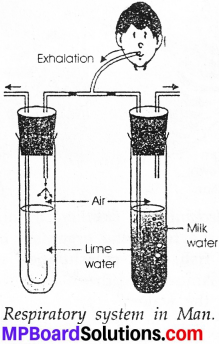
Question 4.
What is the difference in the amount of carbon choxide in the inhaled and the exhaled air? How will you test the presence of CO2 in the exhaled air?
Answer:
Excess carbon dioxide is present in exhaled air as compared inhaled air.
Test to indicate the presence of CO2 in the exhaled air:
Take two test tubes. Fill each of them half with freshly prepared lime water. Fix stoppers with two holes in both the test tubes. Insert glass tubes in both the stoppers. The lime water through which exhaled air is passed turns milky. This shows that more CO2 is present in exhaled air.

Question 5.
Draw diagrams to show movements of rib and diaphragm during breathing?
Answer:
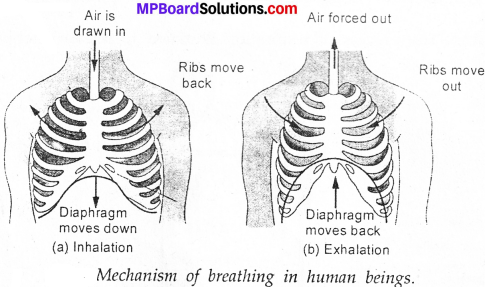
Question 6.
How do the following organism breathe? Amoeba, fish, frog, grasshopper, earthworm?
Answer:
Amoeba:
Amoeba breathes by diffusion of gases in between body surface and the water.
Fish:
Fish breathe with gills. The gills are special organs. They help fish to extract dissolved oxygen from the water.
Frog:
Frog can breathe through skin and lungs. In water if breathes through skin whereas in air through lungs.
Grasshopper:
The grasshopper and other insects have holes and air tubes those help them to breathe.
Earthworm:
It breathes through its moist body surface.
![]()
Question 7.
Describe the breathing in cockroach with diagram?
Answer:
A cockroach has small openings on the sides of its body. Other insects also have similar openings. These openings are called spiracles, bisects have a network of air tubes called tracheae for gas exchange. Oxygen rich air rushes through spiracles into the tracheal tubes, diffuses into the body tissue, and reaches every cell of the body. Similarly, carbon dioxide from the cells goes into the tracheal tubes and moves out through spiracles. These air tubes or tracheae are found only in insects and not in any other group of animals.
